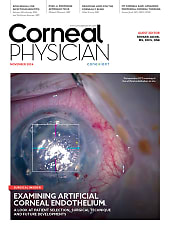Have you ever organized your sock drawer or closet and found that it quickly becomes a mess again? Or, if you have small children, you pick up their toys only to turn around and find them strewn about the room again? What about the kitchen junk drawer you swore you wouldn’t have? Yep. We all do. How do these common problems relate to practice management?
Over time, the same thing happens with processes and employees in a practice—the slippery slope of cutting corners due to time crunches, being short-staffed, or having a large number of new employees.
NOT ONE-AND-DONE
Managing processes and staff is one of the most challenging parts of a business. Whether starting your retina practice or joining an established practice, people—patients and staff—are the lifeblood. However, just like the intravitreal injections you provide to patients, one-and-done usually doesn’t exist. There are a series of treatments, a periodic evaluation of whether a treatment is needed or held, and a need to determine a new treatment plan when the current treatment isn’t working.
The same is true when managing your employees. Every position in the practice has both fixed and flexible components. Gone are the days when the required tasks were specific to a job, such as front desk check-in, work-up tech, surgery scheduler, etc. Now, the position may include one or more of these duties, and may also have overlap for preauthorization, copay collection, and selection of correct diagnosis and procedure codes. The needs of the practice evolve as new regulations and treatments emerge.
FIXED vs FLEXIBLE
Each process in the practice is fixed, flexible, or a combination. Fixed processes are prescribed: if you do not exactly follow certain steps when logging into the practice management system, you will not have access. Other examples include collecting the data necessary for patient demographics or insurance information, procedure and diagnosis code selection, and submission of charges to insurance. Failing to enter patient insurance information correctly, or selecting the incorrect diagnosis code, can cause a claim denial, necessitating duplicative actions to correct and resubmit to the payer. The required fixed elements and the data entry procedures don’t change.
Flexible processes are ones where the process can be changed or the order of steps rearranged when needed. These processes can include interactions with patients or pivoting when short-staffed. For example, the clinic’s normal workflow might be to work up the patient before getting images of the patient’s retina with optical coherence tomography (OCT). But on a day when no workup lanes are available, the OCT imaging could be performed first, followed by the workup, and then the physician will see the patient. All of the necessary steps are performed, just not in the typical order.
Admittedly, there are numerous potential issues in any clinic. However, in retina, emergency patients are often added to the schedule unexpectedly, which affects workflow. Depending on the size of the clinic and the number of physicians, the ability to pivot is essential, and being flexible in a busy retina clinic is critical to success.
Think about typical days: the schedule is perfect—well, as perfect as it can be. Staff showed up on time, no one called out sick, and the patients arrived at their scheduled times. Ah, heaven. But wait: Dr. Smith is calling about a retinal detachment she wants to send over. A patient who had surgery last week is calling to say they can’t see from the surgery eye. The computer in room three keeps shutting down, so you are down a lane. I don’t need to tell you about the crazy days—you already know. Pivoting is always required.
During times of chaos, it is important to exercise flexibility while remembering to execute the necessary fixed steps that ensure that mandatory data is obtained and entered. The art and science are coming together.
TRAINING AND RETRAINING
Think about your patients: After a periodic review of their disease state, you must decide whether to stay with the current treatment plan or pivot to something else. In the same way, a successful clinic leader must evaluate the staff and procedures. While everyone wants to believe that team members know their jobs and are capable of executing them, employees are people who make mistakes and forget steps. Sometimes, it becomes apparent that certain staff members weren’t appropriately trained from the beginning. Regular training and retraining will reinforce good habits and ensure they are following the proper procedures.
Using the monthly staff meeting as training time is an excellent way to keep staff updated on any changes in procedure and reinforce the correct ways to accomplish a task. For example, create review stations for the techs to retrain on Amsler grid use, drop-instillation techniques, evaluation for a relative afferent pupil defect (RAPD), or proper patient prep for an injection. Additionally, the nonclinical staff can learn about the patient journey through the clinic or what it is like to have an OCT done. Or, the billing team could educate the front desk and clinical staff about the revenue cycle and the process for correcting demographic, insurance, or diagnosis/procedure code entry errors. It never hurts for physicians to sit in on these sessions and ask questions, too.

A NEVER-ENDING CYCLE OF IMPROVEMENT
As with the kids’ toys, closet, or junk drawer, there should be a never-ending process of reviewing, evaluating, and deciding to stay the course or make changes in the retina clinic. Whether that is with staff or patients, the management is quite similar. Becoming complacent that the system isn’t broken, so why review it, is not the best plan. Would you keep injecting an eye without periodic evaluation, whether by examination, diagnostic testing, or both? Probably not. So, why would you fail to do the same for the business of your retina practice?
Regularly re-evaluating the practice’s processes is a prudent way to prevent a future crisis. Just as a patient experiencing flashes and floaters for months might wait until they’ve lost vision from a retinal detachment before making an appointment, waiting to address an emergent issue (such as declining reimbursement with a growing accounts receivable) can have damaging—even devastating—effects on your practice.
Treat the retina business as you would a patient: by re-evaluating constantly and revising as necessary. If you find something amiss, make the required changes or provide training to preserve the desired outcome. Then repeat. NRP









